Selected Good Practices in the Hungarian Agricultural Heritage
Abstract
1. Introduction
2. Materials and Methods
2.1. Study Sites
2.1.1. Study Sites for the Description of Wood-Pastures
2.1.2. Study Sites for Orchard Grasslands
2.1.3. Studied Conventional, Organic, and Permaculture Farms
2.2. Methodology
2.2.1. Mapping of Wood-Pastures in the Northern Medium Mountain Ranges of Hungary
2.2.2. Botanical Survey of the Selected Orchard Grasslands
2.2.3. Description of Permaculture Farms with Forest Gardens – Case Studies
2.2.4. Comparative Analysis of Soil Organic Matter in Conventional, Organic, and Permaculture Farms
3. Results
3.1. Wood-Pastures of the Northern Medium Mountain Ranges of Hungary
- -
- http://www.termeszetvedelem.hu/index.php?pg=menu_2774 (accessed on 31 May 2021)—search page of the Ministry of Agriculture for national and local protected areas based on
- -
- the Nature Conservation Law of Hungary (LIII of 1996) and
- -
- the 13/1997. (V. 28) decree of KTM (Ministry for Environment and Nature) on the registration of protected natural areas and values.
3.2. Nature Conservation Values of Species Related to Hungarian Orchard Grasslands
3.3. Description of Permaculture Farms with Forest Gardens – Case Studies
3.4. Comparative Analysis of Soil Organic Matter in Permaculture, Organic and Conventional Farms
4. Discussion
5. Conclusions
Author Contributions
Funding
Institutional Review Board Statement
Informed Consent Statement
Data Availability Statement
Conflicts of Interest
References
- Fróna, D.; Szenderák, J.; Harangi-Rákos, M. The Challenge of Feeding the World. Sustainability 2019, 11, 5816. [Google Scholar] [CrossRef]
- Mehrabi, Z.; Ellis, E.C.; Ramankutty, N. The challenge of feeding the world while conserving half the planet. Nat. Sustain. 2018, 1, 409–412. [Google Scholar] [CrossRef]
- Dover, M.; Talbot, L. To Feed the Earth Agro-Ecology for Sustainability in a Changing World Order; World Resources Institute: Washington, DC, USA, 1987; p. 122. [Google Scholar]
- Pimentel, D.; McLaughlin, L.; Zepp, A.; Lakitan, B.; Kraus, T.; Kleinman, P.; Vancini, F.; Roach, W.; Graap, E.; Keeton, W.S.; et al. Environmental and economic effects of reducing pesticide use in agriculture. Agric. Ecosyst. Environ. 1993, 46, 273–288. [Google Scholar] [CrossRef]
- Santoro, A.; Venturi, M.; Ben Maachia, S.; Benyahia, F.; Corrieri, F.; Piras, F.; Agnoletti, M. Agroforestry Heritage Systems as Agrobiodiversity Hotspots. The Case of the Mountain Oases of Tunisia. Sustainability 2020, 12, 4054. [Google Scholar] [CrossRef]
- Centeri, C.; Renes, H.; Roth, M.; Kruse, A.; Eiter, S.; Kapfer, J.; Santoro, A.; Agnoletti, M.; Emanueli, F.; Sigura, M.; et al. Wooded Grasslands as Part of the European Agricultural Heritage. In Environmental History in the Making; Springer: Berlin/Heidelberg, Germany, 2016; Volume 5, pp. 75–103. [Google Scholar]
- Gillet, F. Modelling vegetation dynamics in heterogeneous pasture-woodland landscapes. Ecol. Model. 2008, 217, 1–18. [Google Scholar] [CrossRef]
- Garbarino, M.; Lingua, E.; Subirà, M.M.; Motta, R. The larch wood pasture: Structure and dynamics of a cultural landscape. Eur. J. For. Res. 2010, 130, 491–502. [Google Scholar] [CrossRef]
- Nel, L.; Szilágyi, A. Selection of indicators for assessment of soil-related agricultural ecosystem services and sustainable management. In 25th International Poster Day and Institute of Hydrology Open day: Transport of Water, Chemicals and Energy in the Soil-Plant-Atmosphere System; Anežka, Č., Ed.; Institute of Hydrology SAS: Bratislava, Slovakia, 2018; pp. 103–118. ISBN 9788089139422. [Google Scholar]
- Lesschen, J.P.; Elbersen, B.; Hazeu, G.; van Doorn, A.; Mucher, S.; Velthof, G. Task 1—Defining and Classifying Grasslands in Europe. In Final Report March 2014; Alterra, part of Wageningen UR: Wageningen, The Netherlands, 2014. [Google Scholar]
- Joffre, R.; Vacher, J.; de Llanos, C.; Long, G. The dehesa: An agrosilvopastoral system of the Mediterranean region with special reference to the Sierra Morena area of Spain. Agrofor. Syst. 1988, 6, 71–96. [Google Scholar] [CrossRef]
- Rackham, O. Trees and Woodland in the British Landscape—The Complete History of Britain’s Trees, Woods és Hedgerows; Phoenix Giant: London, UK, 1996; p. 234. [Google Scholar]
- Manning, A.; Fischer, J.; Lindenmayer, D.B. Scattered trees are keystone structures—Implications for conservation. Biol. Conserv. 2006, 132, 311–321. [Google Scholar] [CrossRef]
- Rois-Díaz, M.; Mosquera-Losada, R.; Rigueiro-Rodríguez, A. Biodiversity Indicators on Silvopastoalism across Europe. EFI Technical Report 21; European Forest Institute: Joensuu, Finland, 1999; p. 66. [Google Scholar]
- Vera, F.W.M. Grazing Ecology and Forest History; CABI: Wallingford, UK, 2000; p. 506. [Google Scholar]
- Schnabel, S.; Ferreira, A. Sustainability of Agrosilvopastoral Systems—Dehesas, Montados; Advances in Geoecology: Reiskirchen, Germany, 2004; Volume 37. [Google Scholar]
- Eichhorn, M.P.; Paris, P.; Herzog, F.; Incoll, L.D.; Liagre, F.; Mantzanas, K.; Mayus, M.; Moreno, G.; Papanastasis, V.P.; Pilbeam, D.J.; et al. Silvoarable Systems in Europe—Past, Present and Future Prospects. Agrofor. Syst. 2006, 67, 29–50. [Google Scholar] [CrossRef]
- Holl, K.; Smith, M. Scottish upland forests: History lessons for the future. For. Ecol. Manag. 2007, 249, 45–53. [Google Scholar] [CrossRef]
- Bergmeier, E.; Petermann, J.; Schröder, E. Geobotanical survey of wood-pasture habitats in Europe: Diversity, threats and conservation. Biodivers. Conserv. 2010, 19, 2995–3014. [Google Scholar] [CrossRef]
- Tiessen, H.; Menezes, R.; Salcedo, I.; Wick, B. Organic matter transformations and soil fertility in a treed pasture in semiarid NE Brazil. Plant Soil 2003, 252, 195–205. [Google Scholar] [CrossRef]
- Ellis, E.A.; Nair, P.; Jeswani, S.D. Development of a web-based application for agroforestry planning and tree selection. Comput. Electron. Agric. 2005, 49, 129–141. [Google Scholar] [CrossRef]
- Keesman, K.J.; Graves, A.; Van Der Werf, W.; Burgess, P.J.; Palma, J.; Dupraz, C.; Van Keulen, H. A system identification approach for developing and parameterising an agroforestry system model under constrained availability of data. Environ. Model. Softw. 2011, 26, 1540–1553. [Google Scholar] [CrossRef]
- Nair, P.K.R.; Garrity, D. Agroforestry research and development—The way forward. In Agroforestry—The Future of Global Land Use; Nair, P.K.R., Garrity, D., Eds.; Springer: Dordrecht, Germany, 2012; p. 541. [Google Scholar]
- Jose, S. Agroforestry for conserving and enhancing biodiversity. Agrofor. Syst. 2012, 85, 1–8. [Google Scholar] [CrossRef]
- Jørgensen, D.; Quelch, P. The origins and history of medieval wood-pastures. In European Wood-Pastures in Transition: A Social-Ecological Approach; Hartel, T., Plieninger, T., Eds.; Taylor & Francis Group: New York, NY, USA, 2014; pp. 55–69. [Google Scholar]
- Molnár, Z.; Bölöni, J.; Horváth, F. Threatening factors encountered: Actual endangerment of the Hungarian (semi-) natural habitats. Acta Bot. Hung. 2008, 50, 199–217. [Google Scholar] [CrossRef]
- Bölöni, J.; Molnár, Z.; Bíró, M.; Horváth, F. Distribution of the (semi-) natural habitats in Hungary II. Woodlands and shrublands. Acta Bot. Hung. 2008, 50, 107–148. [Google Scholar] [CrossRef]
- Petercsák, T. The role of forest in the mountain animal husbandry. In A Herman Ottó Múzeum Évkönyve 16; Bodó, S., Szabadfalvi, J., Eds.; Annales Musei Miskolciensis De Herman Otto Nominati: Miskok, Hunguary, 1977; pp. 295–309. (In Hungarian) [Google Scholar]
- Petercsák, T. The forest in the peasant farming if the Northern Medium Mountain Range (18th to 20th century). Studia Folklor. Ethnogr. 1992, 30, 239. (In Hungarian) [Google Scholar]
- Mravcsik, Z.; Harmos, K.; Malatinszky, Á. Studies on botany and landscape history of abandoned grapeyards in the Northern Cserhát Hills, Hungary. Tájökológiai Lapok 2009, 7, 473–484. [Google Scholar]
- Dobrovodská, M.; Kanka, R.; David, S.; Kollár, J.; Špulerová, J.; Štefunková, D.; Mojses, M.; Petrovič, F.; Kristin, A.; Stašiov, S.; et al. Assessment of the biocultural value of traditional agricultural landscape on a plot-by-plot level: Case studies from Slovakia. Biodivers. Conserv. 2019, 28, 2615–2645. [Google Scholar] [CrossRef]
- Forejt, M.; Syrbe, R.-U. The current status of orchard meadows in Central Europe: Multi-source area estimation in Saxony (Germany) and the Czech Republic. Morav. Geogr. Rep. 2019, 27, 217–228. [Google Scholar] [CrossRef]
- Malatinszky, Á.; Siller, I.; Penksza, K. Abandoned loessy grape yards as refuges of rare steppe plant species. Cereal Res. Commun. 2008, 36, 1139–1142. [Google Scholar]
- Herzog, F. Streuobst: A traditional agroforestry system as a model for agroforestry development in temperate Europe. Agrofor. Syst. 1998, 42, 61–80. [Google Scholar] [CrossRef]
- Bouvier, J.-C.; Boivin, T.; Lavigne, C. Conservation value of pome fruit orchards for overwintering birds in southeastern France. Biodivers. Conserv. 2020, 29, 3169–3189. [Google Scholar] [CrossRef]
- Zarnovican, H.; Kollár, J.; Škodová, I. Grassland communities of traditional orchards in the Western Carpathians (Slovakia). Acta Soc. Bot. Pol. 2017, 86, 3552. [Google Scholar] [CrossRef]
- Kun, R.; Bartha, S.; Malatinszky, Á.; Molnár, Z.; Lengyel, A.; Babai, D. “Everyone does it a bit differently!”: Evidence for a positive relationship between micro-scale land-use diversity and plant diversity in hay meadows. Agric. Ecosyst. Environ. 2019, 283, 106556. [Google Scholar] [CrossRef]
- Mollison, B. Permaculture, A Designer’s Manual; Tagari Publications: Sisters Creek, Australia, 1988; p. 565. [Google Scholar]
- Holmgren, D.; Mollison, B. Permaculture One: A Perennial Agriculture for Human Settlements; Tagari Publications: Sisters Creek, Australia, 1990; p. 127. [Google Scholar]
- Holmgren, D. Permaculture, Principles & Pathways Beyond Sustainability; Permanent Publications: Hampshire, UK, 2002; p. 286. [Google Scholar]
- Baji, B. Permakultúra és Önellátó Biogazdálkodás, 3rd ed.; Első Lánchíd Bt.: Biri, Hunguary, 2013; p. 224. [Google Scholar]
- Jacke, D.; Toensmeier, E. Edible forest gardens. In Ecological Vision and Theory for Temperate Climate Permaculture; Chelsea Green Publishing: Chelsea, VT, USA, 2005; Volume 1, p. 396. [Google Scholar]
- Ferguson, R.S.; Lovell, S. Permaculture for agroecology: Design, movement, practice, and worldview. A review. Agron. Sustain. Dev. 2014, 34, 251–274. [Google Scholar] [CrossRef]
- Crawford, M. Creating a Forest Garden: Working with Nature to Grow Edible Crops; Chelsea Green Publishing: Chelsea, VT, USA, 2010; p. 384. [Google Scholar]
- Saláta, D. Az Északi-Középhegység fás Legelőinek Tipológiája és Természetvédelmi Vonatkozásai (Tipology and Nature Conservational Aspects of Wood Pastures in the North Hungarian Mountains, English Thesis); Szent István Egyetem, Környezettudományi Doktori Iskola: Gödöllő, Hunguary, 2017; p. 131. Available online: http://phd.szie.hu/?docId=15658 (accessed on 31 May 2021).
- Bartha, D. Történelmi erdőhasználatok Magyarországon. Magy. Tudomány 2003, 12, 90–102. [Google Scholar]
- Szabó, P. Woodland and Forests in Medieval Hungary. In Woodland and Forests in Medieval Hungary; BAR Publishing: Oxford, UK, 2005; p. 187. [Google Scholar]
- Varga, A.; Bölöni, J.; Saláta, D.; Biró, M.; Horváth, F.; Samu, Z.T.; Bodor, Á.; Molnár, Z. Magyarországi Fáslegelők és Legelőerdők Jelenlegi Természetvédelmi Helyzete és Problémái (Present state and Problems of Nature Conservation of Hungarian Wood-pastures and Pasture Forests). In Aktuális Flóra—És Vegetációkutatás a Kárpát-medencében Nemzetközi Konferencia Absztraktkötete (Actual Flora and Vegetation Research of the Carpathian Basin); Schmidt, D., Kovács, M., Bartha, D., Eds.; Nyugat-magyarországi Egyetemi Kiadó: Sopron, Hunguary, 2014; p. 225. [Google Scholar]
- Varga, A.; Molnár, Á.; Tölgyesi, C.; Gallé, R.; Molnár, Z. Az Erdei Legeltetés Hatásainak Vizsgálata a Duna–Tisza-Közén; Budapest–Vácrátót, Kiskunság National Park Directorate-Hungarian Academy of Science Centre for Ecological Research: Budapest, Hungary, 2015; p. 107. [Google Scholar]
- Plieninger, T.; Levers, C.; Mantel, M.; Costa, A.; Schaich, H.; Kuemmerle, T. Patterns and Drivers of Scattered Tree Loss in Agricultural Landscapes: Orchard Meadows in Germany (1968–2009). PLoS ONE 2015, 10, e0126178. [Google Scholar] [CrossRef]
- Steffan-Dewenter, I.; Leschke, K. Effects of habitat management on vegetation and above-ground nesting bees and wasps of orchard meadows in Central Europe. Biodivers. Conserv. 2003, 12, 1953–1968. [Google Scholar] [CrossRef]
- Tscharntke, T.; Steffan-Dewenter, I.; Kruess, A.; Thies, C. Contribution of small habitat fragments to conservation of insect communities of grassland-cropland landscapes. Ecol. Appl. 2002, 12, 354–363. [Google Scholar]
- Schönhart, M.; Schauppenlehner, T.; Schmid, E.; Muhar, A. Analysing the maintenance and establishment of orchard meadows at farm and landscape levels applying a spatially explicit integrated modelling approach. J. Environ. Plan. Manag. 2011, 54, 115–143. [Google Scholar] [CrossRef]
- Camagni, R. Regional Competitiveness: Towards a Concept of Territorial Capital. In Modelling Regional Scenarios for the Enlarged Europe; Capello, R., Camagni, R., Fratesi, U., Chizzolini, B., Eds.; Springer: Berlin/Heidelberg, Germany, 2008; pp. 33–48. [Google Scholar]
- Daily, G.C. Nature’s Services: Societal Dependence on Natural Ecosystems; Island Press: Washington, DC, USA, 1997. [Google Scholar]
- Kovács, E.; Kelemen, E.; Kalóczkai, Á.; Margóczi, K.; Pataki, G.; Gébert, J.; Málovics, G.; Balázs, B.; Roboz, Á.; Krasznai Kovács, E.; et al. Understanding the links between ecosystem service trade-offs and conflicts in protected areas. Ecosyst. Serv. 2015, 12, 117–127. [Google Scholar] [CrossRef]
- Prohászka, V.; Kollányi, L.; Máté, L.; Zaja, P.; Lantos, T.; Kovács, E. Assessment of ecosystem services in adaptive orchard meadows in Visnyeszéplak. In Sustainability in Transforming Societies, Proceedings of the 26th Annual Conference of the International Sustainable Development Research Society Budapest, Hungary, 15–17 July 2020; Zilahy, G., Ed.; Faculty of Economic and Social Sciences, Budapest University of Technology and Economics: Budapest, Hungary, 2020; pp. 948–956. [Google Scholar]
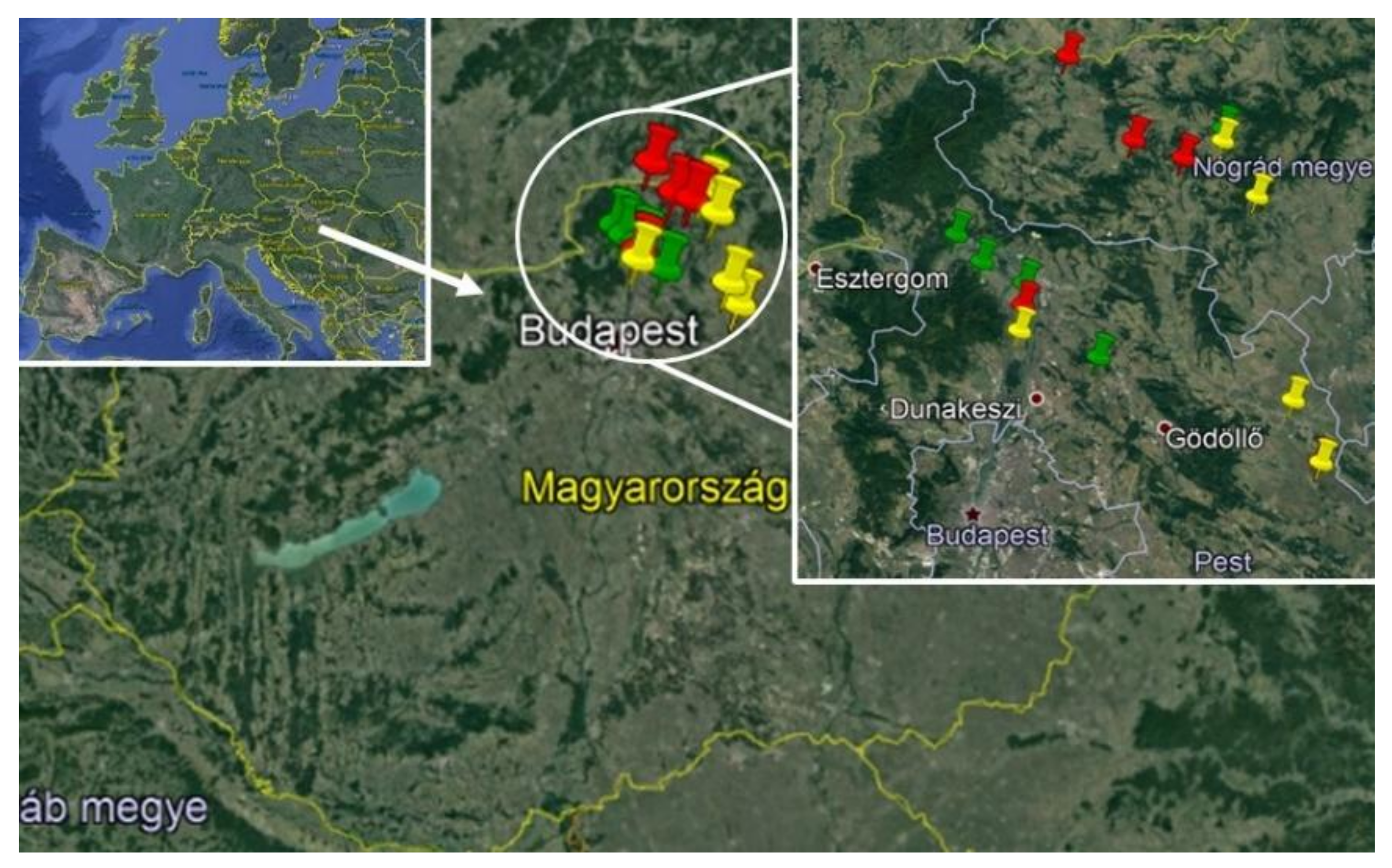
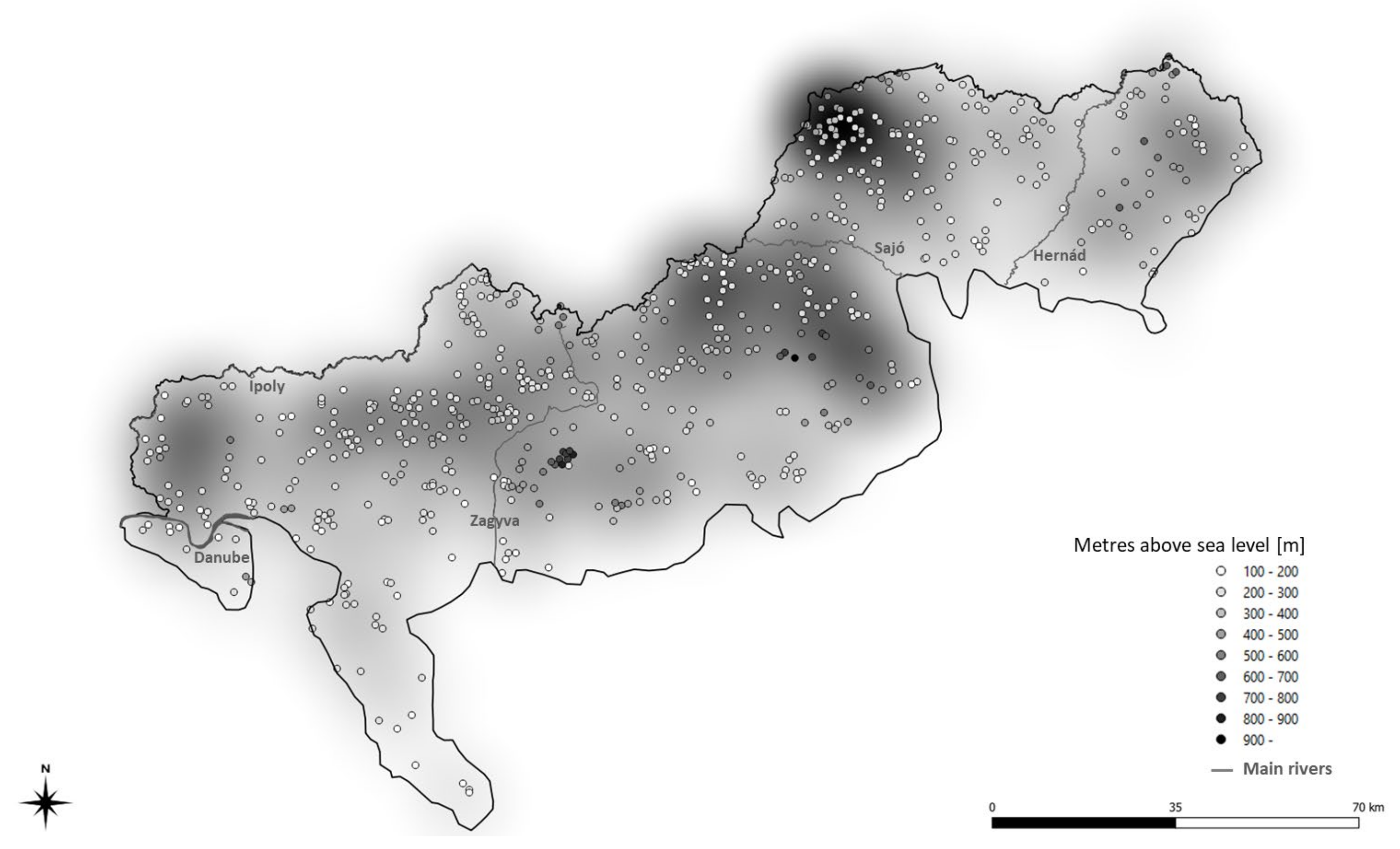
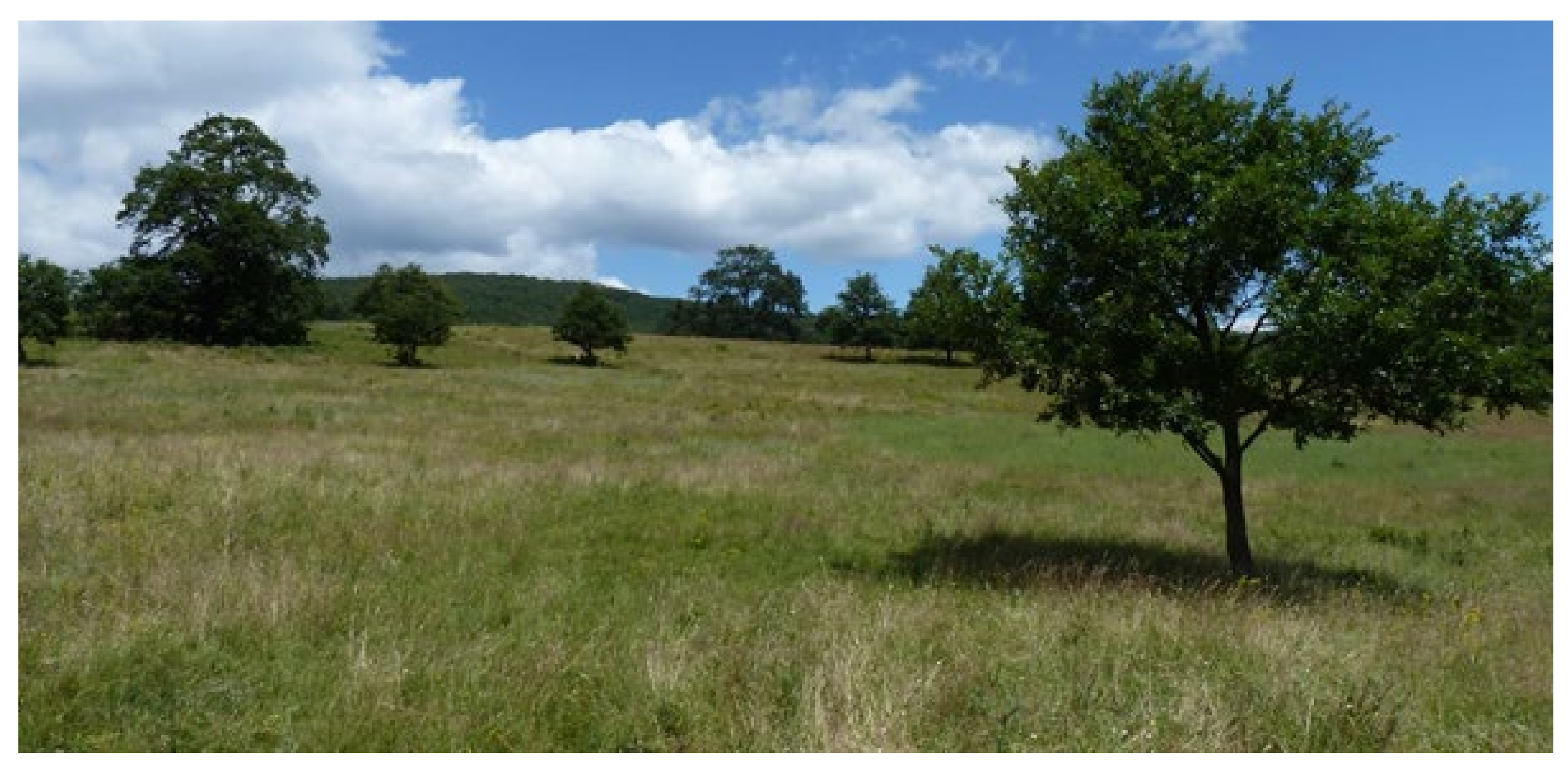
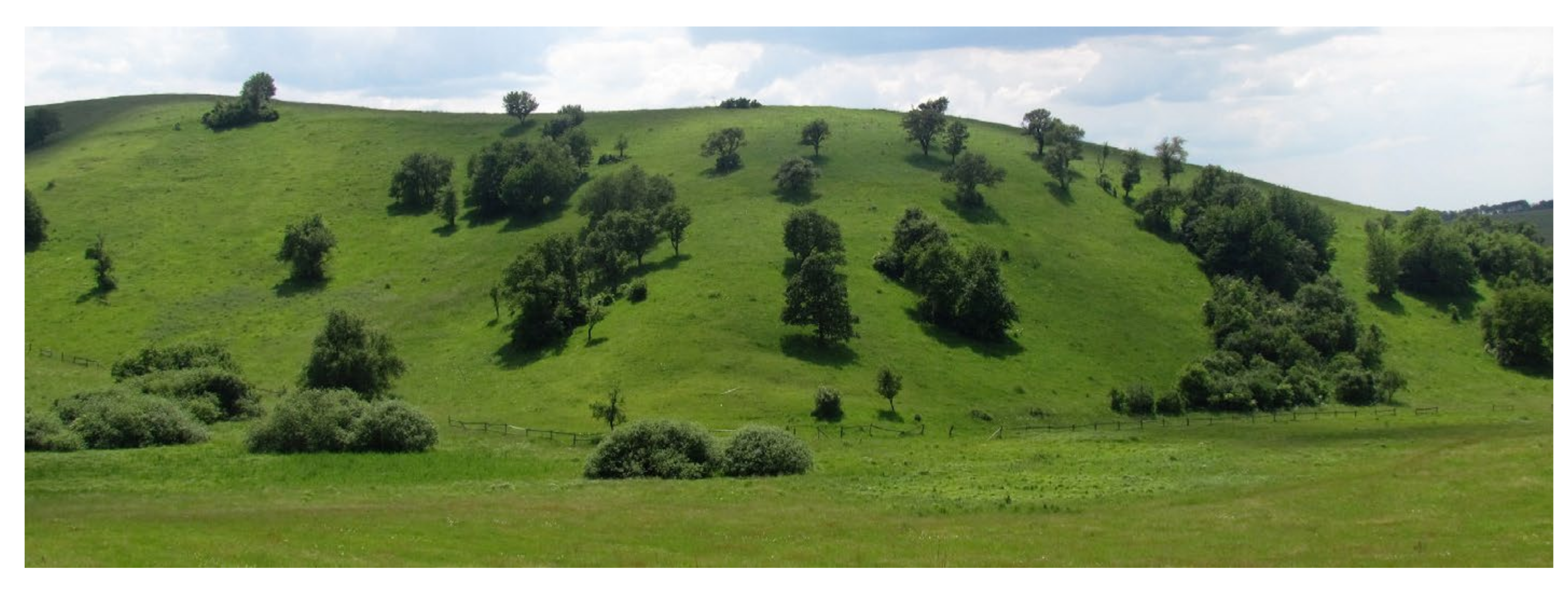
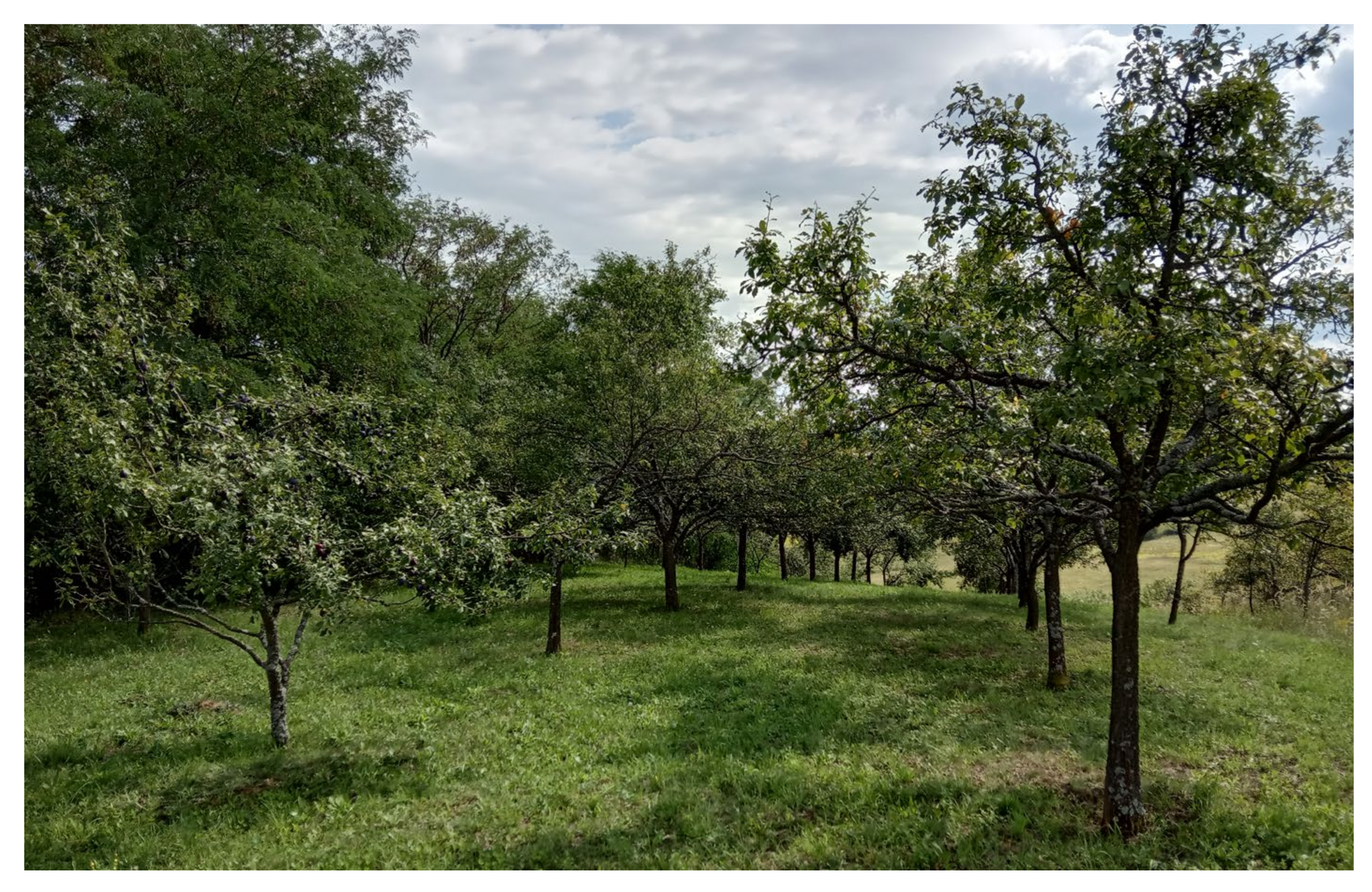
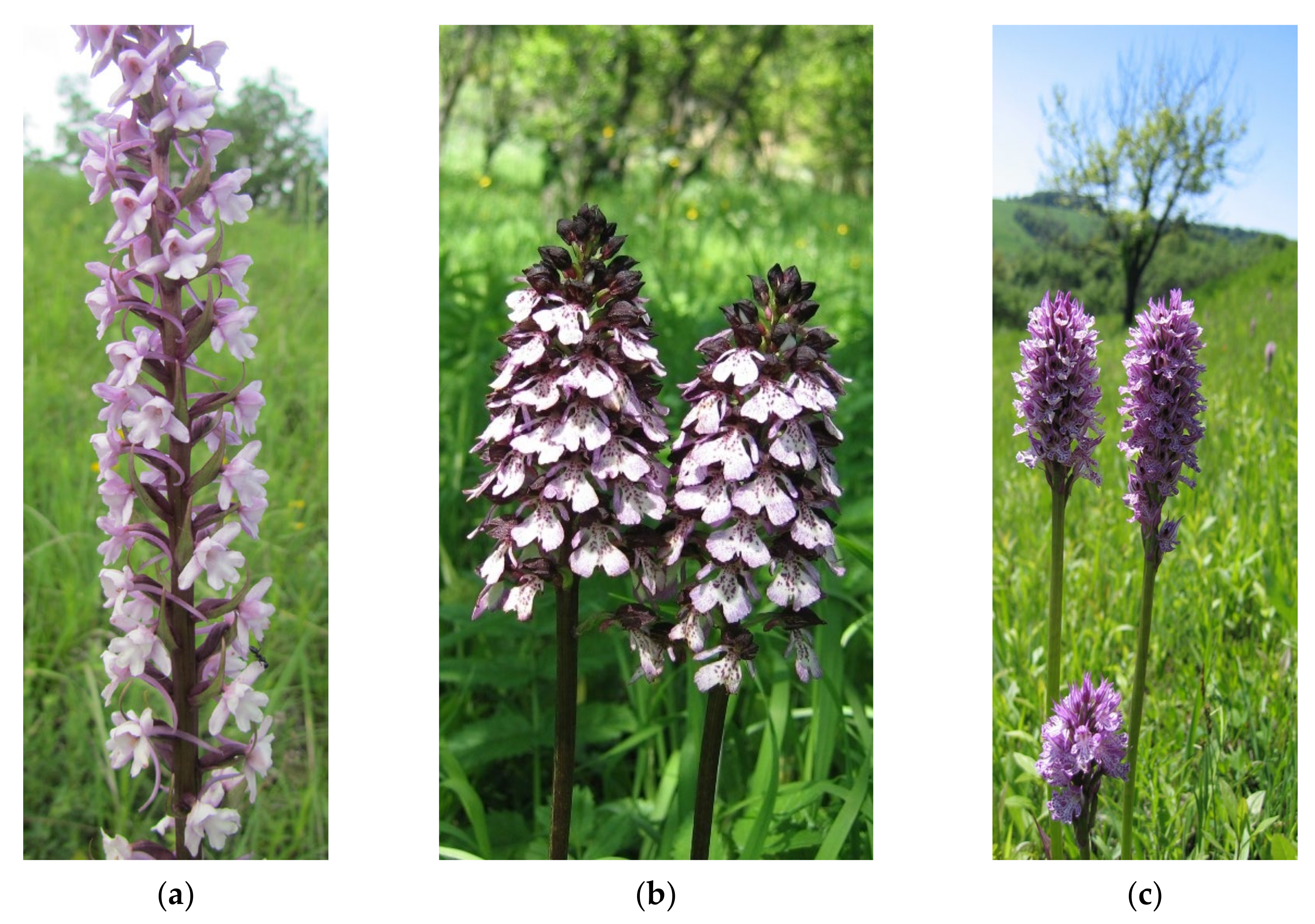
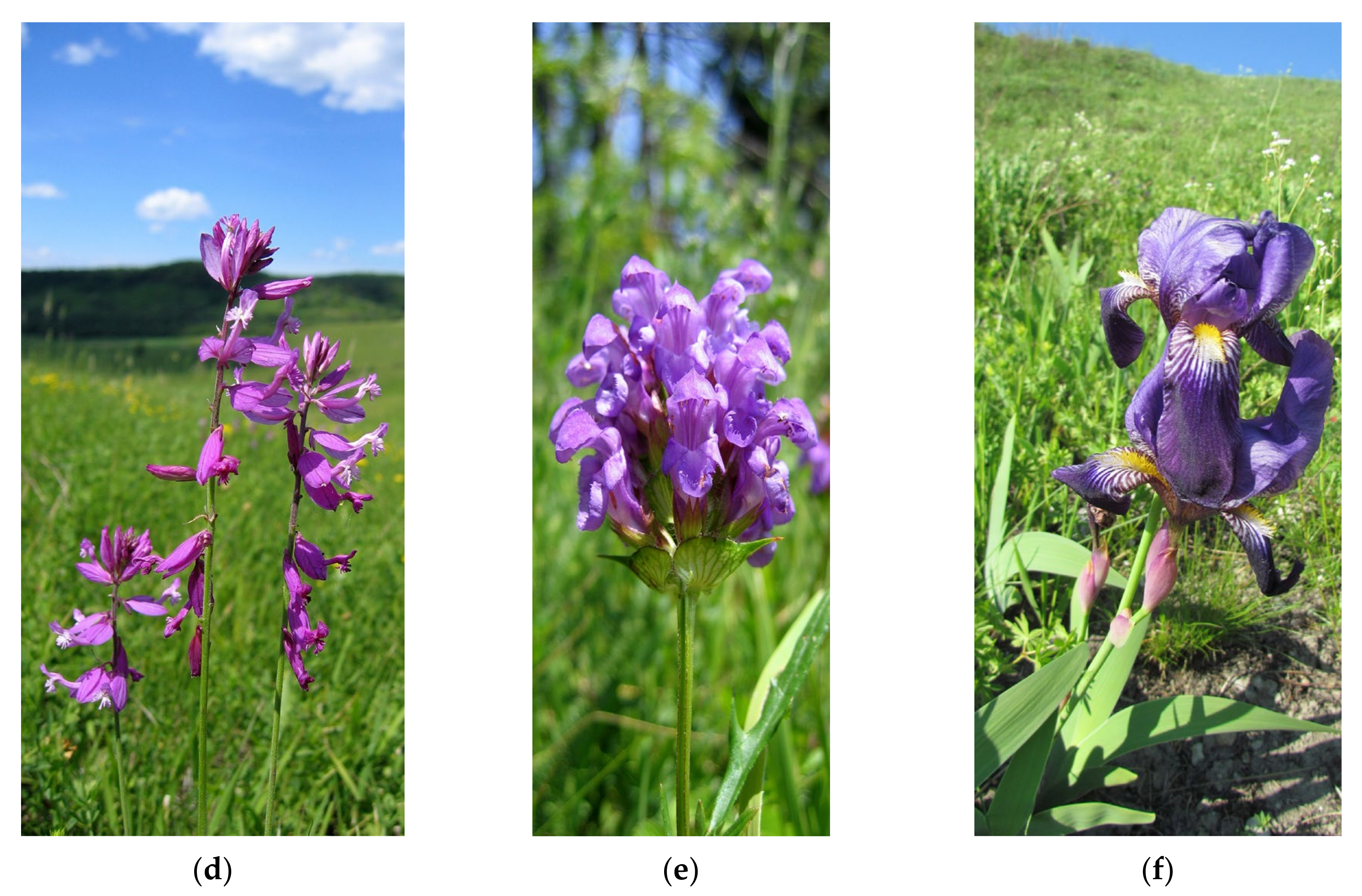
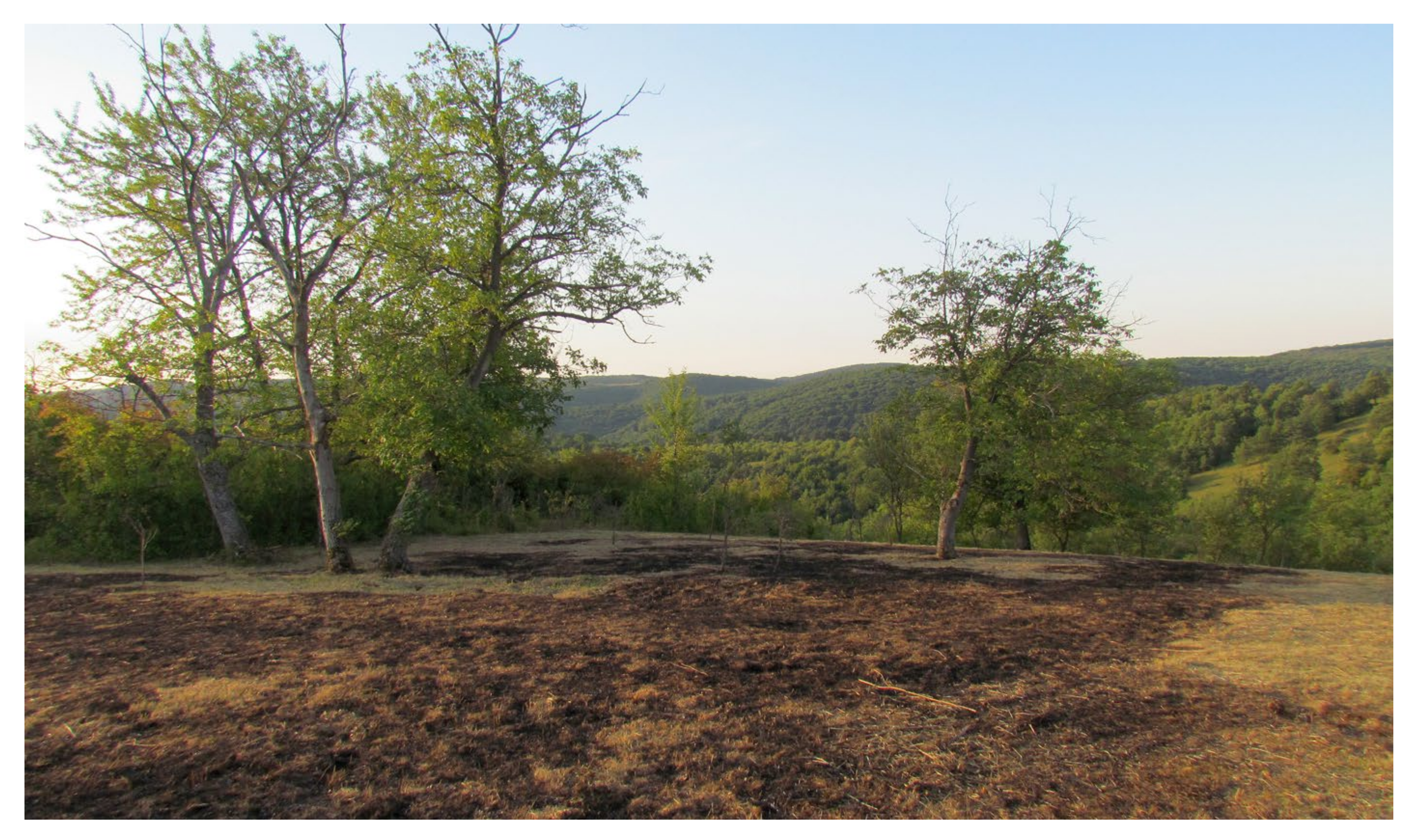
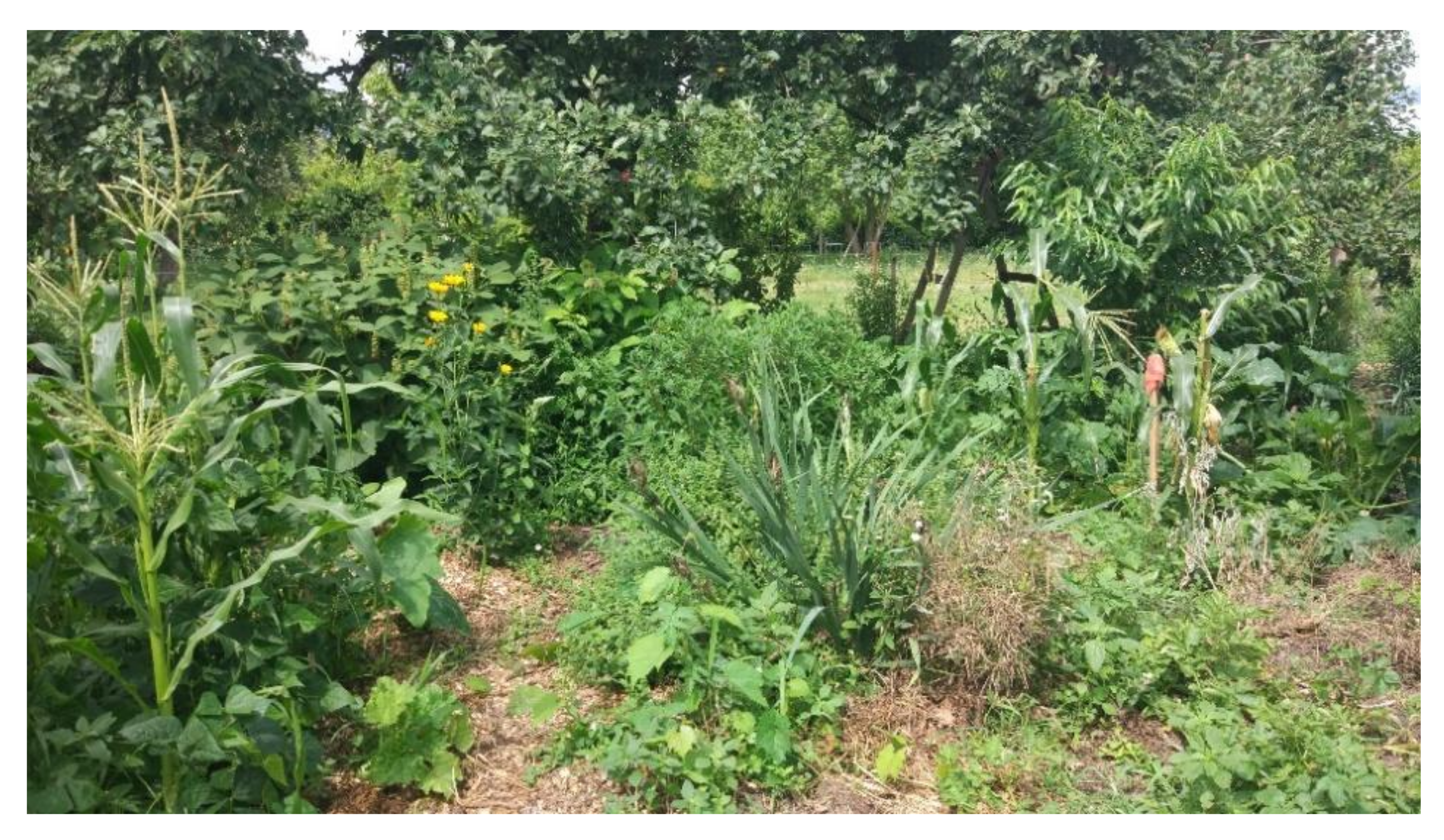

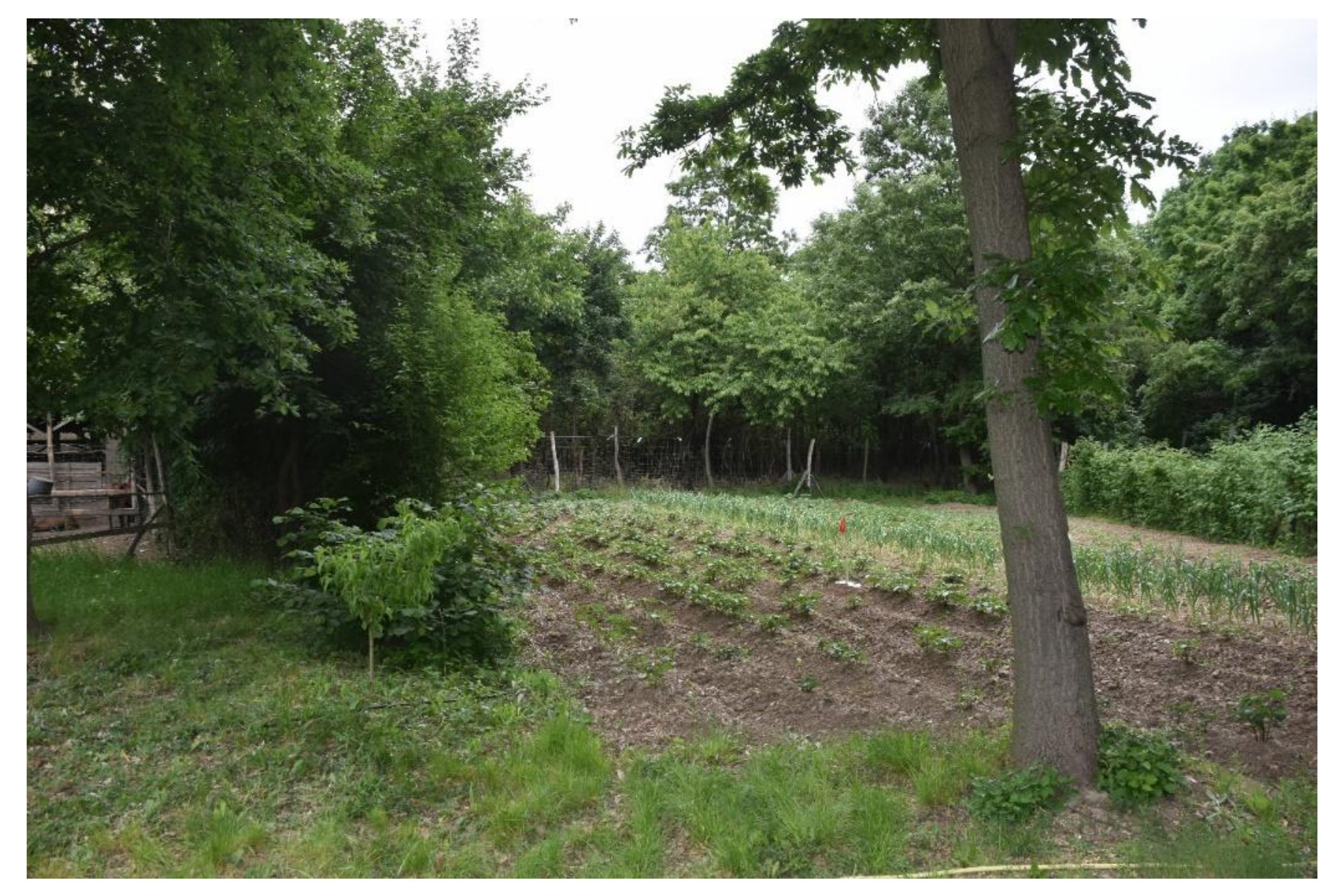
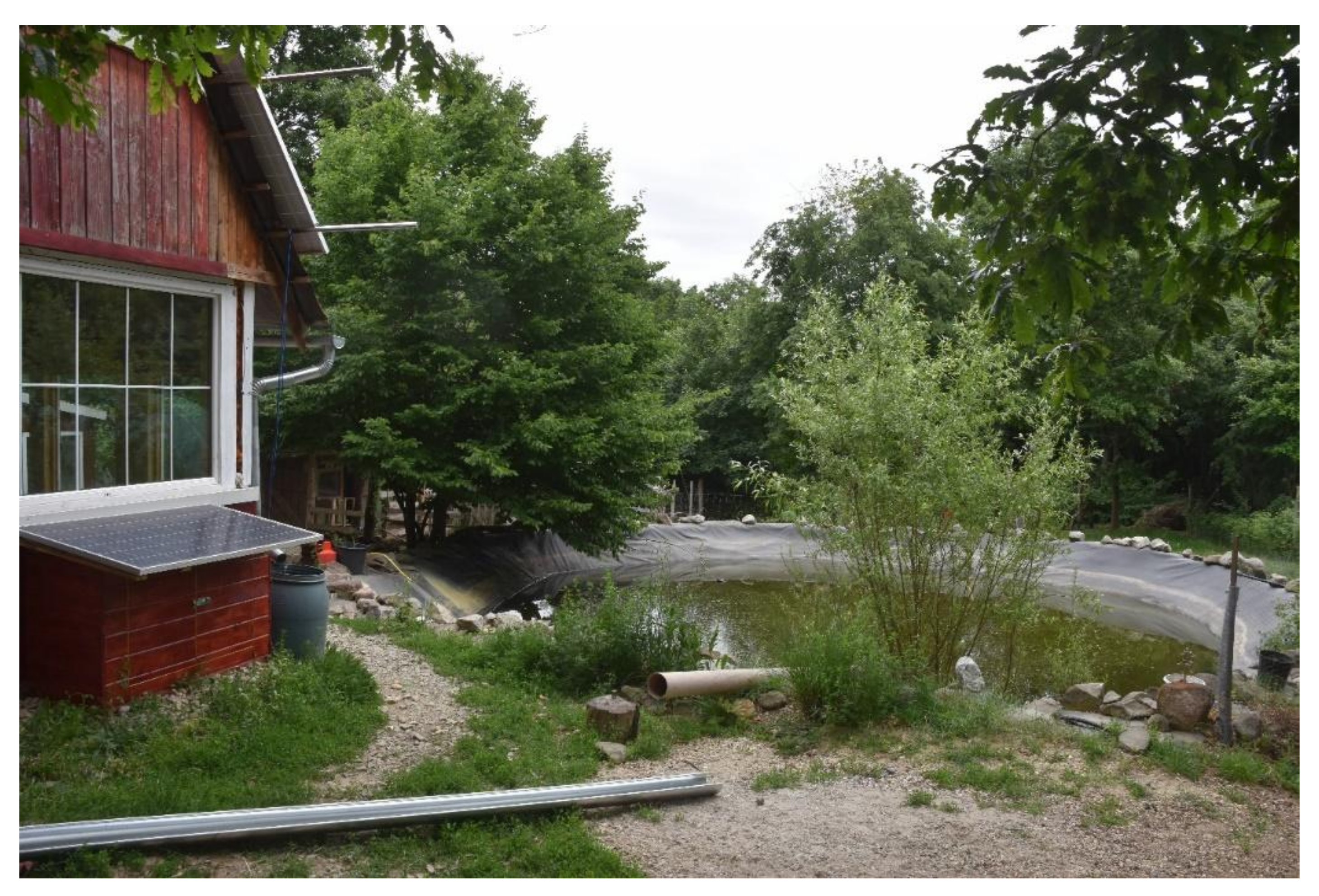

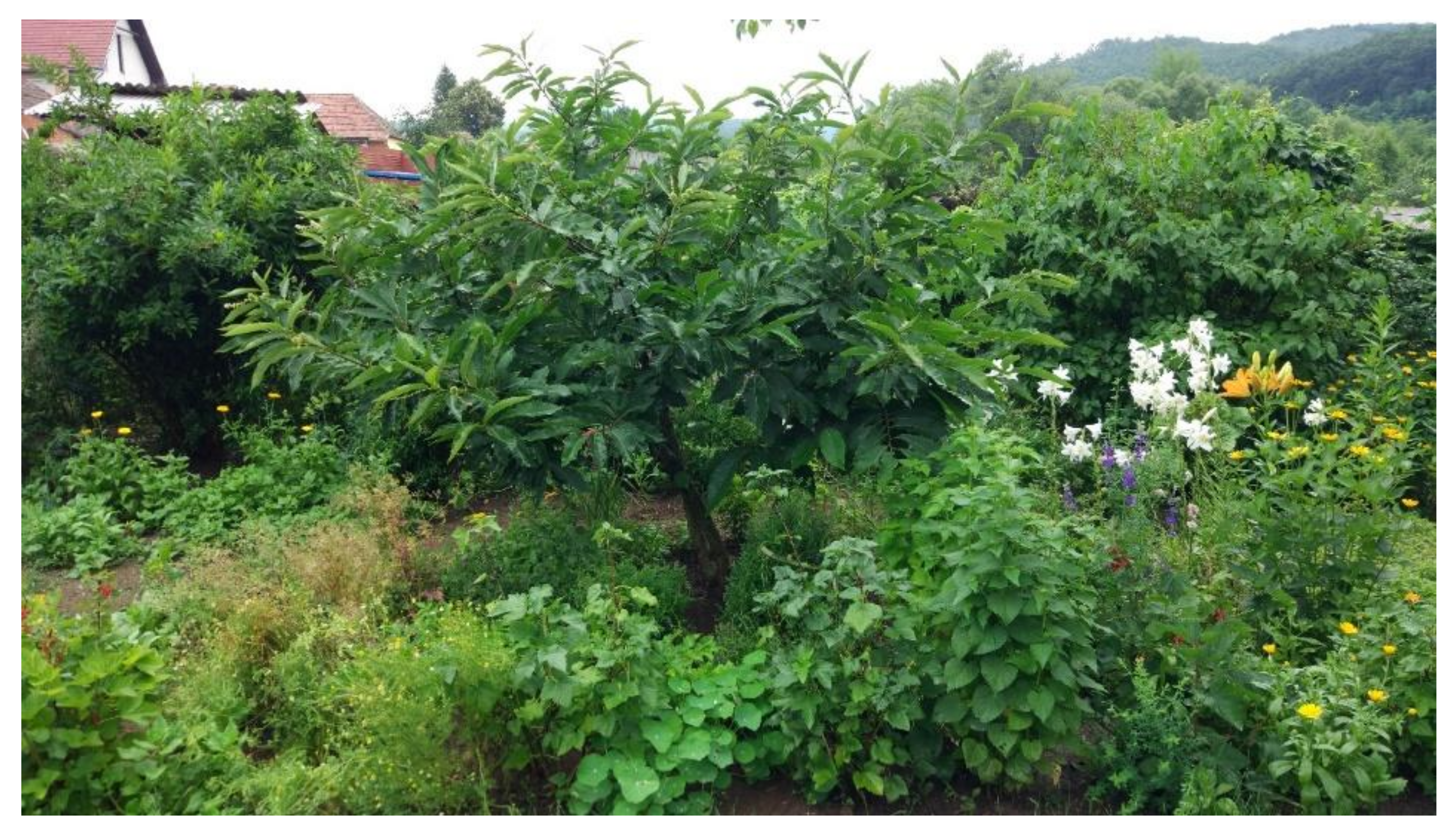
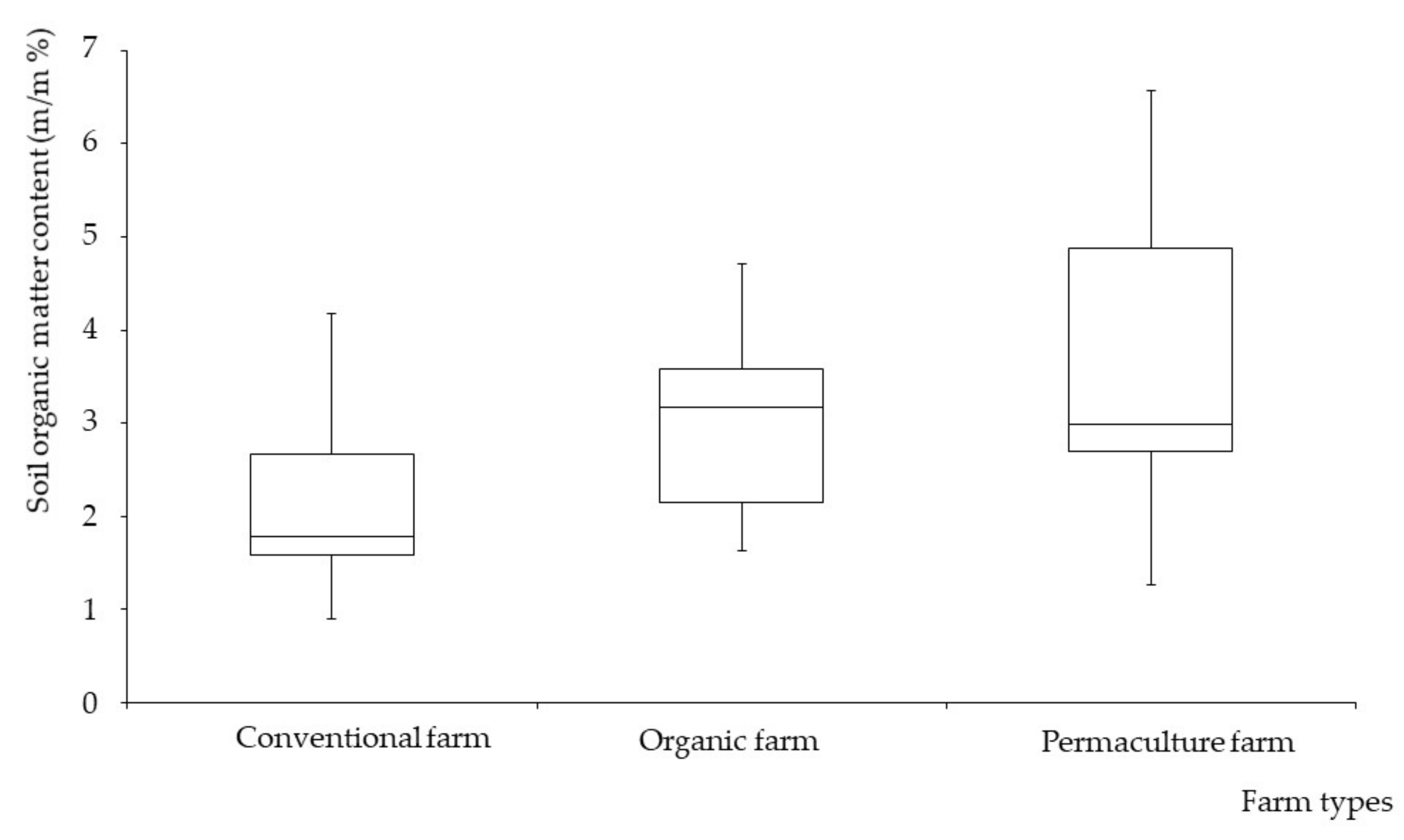
| Farms | Size of Horticulture Production (ha) | Soil Type (WRB, 2015) | Total Thickness of All Humus Layers (cm) | Comments |
|---|---|---|---|---|
| C1 | 0.75 | Chernozem | 0–50 | conventional tillage, plowing, no mulch, medium irrigation |
| C2 | 0.5 | Luvisol | 0 | conventional tillage, plowing, rotation hoe, no mulch, minimum irrigation, slightly sandy soil |
| C3 | 0.2 | Luvisol | 0 | no/minimum tillage or shallow cultivation, professional irrigation |
| C4 | 0.4 | Fluvisol | 0–70 | medium irrigation, frequent use of rotation hoes (soil cultivation+ weed killing), no mulch |
| C5 | 1.5 | Luvisol | 0–100 | intensive irrigation (flooding and dripping), intensive soil cultivation (tillage, ridge cultivation, cultivator), no mulch, |
| O1 | 1 | Chernozem | 0–58 | minimal soil disturbance with shallow cultivation, permanent beds, compost covering, permanent professional irrigation, clayey, extensive compost use, wood chips on cultivation paths, a yellow, clayey layer at 60 cm depth |
| O2 | 0.35 | Arenosol | 0–20 | continuous irrigation, sandy soil, no mulching, no earthworms probably due to the very sandy soil texture |
| O3 | 0.3 | Luvisol | 0–41 | very clayey soil, medium compaction, irrigation, permanent beds, shallow soil cultivation |
| O4 | 0.5 | Luvisol | 0–20 | clayey soil, hard compaction, irrigation, permanent beds, shallow soil cultivation |
| O5 | 2 | Luvisol | 0–84 | intensive machinery, very weedy, no mulch, intensive irrigation |
| P1 | 0.5 | Arenosol | 0–30 | very extensive, no irrigation, lot of weeds, sandy soil |
| P2 | 0.7 | Luvisol | 0–30 | minimal soil disturbance with shallow cultivation, permanent beds, compost covering, permanent professional irrigation, clayey, extensive compost use |
| P3 | 0.8 | Luvisol | 0–67 | normal soil cultivation, compost covering, permanent professional irrigation |
| P4 | 0.6 | Luvisol | 0–23 | very steep area, rocky/shallow soil, clayey, soil structure has larger aggregates (0.5–1 cm), some irrigation, some soil tillage |
| P5 | 0.2 | Fluvisol | 0–105 | minimal irrigation, forest garden, thick mulch, polyculture beds |
| Farm Code | Average (n = 5) SOM (%) | Farm Code | Average (n = 5) SOM (%) | Farm Code | Average (n = 5) SOM (%) |
|---|---|---|---|---|---|
| P1 | 1.6 | O1 | 3.4 | C1 | 3.0 |
| P2 | 5.2 | O2 | 3.2 | C2 | 1.6 |
| P3 | 3.1 | O3 | 3.0 | C3 | 2.8 |
| P4 | 3.0 | O4 | 2.9 | C4 | 1.6 |
| P5 | 5.3 | O5 | 2.1 | C5 | 1.5 |
| Farm Types | Average SOM (%) Values | Standard Deviation at the Farming System Level |
|---|---|---|
| Permaculture (n = 5) | 3.6 | 1.65 |
| Organic (n = 5) | 2.9 | 0.83 |
| Conventional (n = 5) | 2.1 | 0.80 |
Publisher’s Note: MDPI stays neutral with regard to jurisdictional claims in published maps and institutional affiliations. |
© 2021 by the authors. Licensee MDPI, Basel, Switzerland. This article is an open access article distributed under the terms and conditions of the Creative Commons Attribution (CC BY) license (https://creativecommons.org/licenses/by/4.0/).
Share and Cite
Centeri, C.; Saláta, D.; Szilágyi, A.; Orosz, G.; Czóbel, S.; Grónás, V.; Gyulai, F.; Kovács, E.; Pető, Á.; Skutai, J.; et al. Selected Good Practices in the Hungarian Agricultural Heritage. Sustainability 2021, 13, 6676. https://doi.org/10.3390/su13126676
Centeri C, Saláta D, Szilágyi A, Orosz G, Czóbel S, Grónás V, Gyulai F, Kovács E, Pető Á, Skutai J, et al. Selected Good Practices in the Hungarian Agricultural Heritage. Sustainability. 2021; 13(12):6676. https://doi.org/10.3390/su13126676
Chicago/Turabian StyleCenteri, Csaba, Dénes Saláta, Alfréd Szilágyi, György Orosz, Szilárd Czóbel, Viktor Grónás, Ferenc Gyulai, Eszter Kovács, Ákos Pető, Julianna Skutai, and et al. 2021. "Selected Good Practices in the Hungarian Agricultural Heritage" Sustainability 13, no. 12: 6676. https://doi.org/10.3390/su13126676
APA StyleCenteri, C., Saláta, D., Szilágyi, A., Orosz, G., Czóbel, S., Grónás, V., Gyulai, F., Kovács, E., Pető, Á., Skutai, J., Biró, Z., & Malatinszky, Á. (2021). Selected Good Practices in the Hungarian Agricultural Heritage. Sustainability, 13(12), 6676. https://doi.org/10.3390/su13126676








